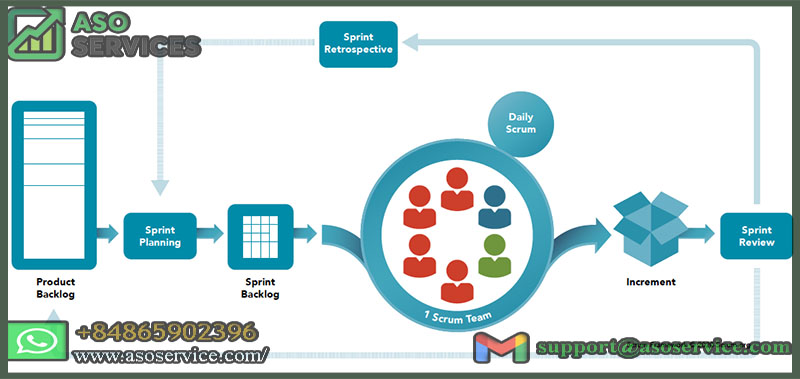Scrum methodology is a popular framework for implementing agile project management, enabling teams to collaborate, adapt, and deliver high-quality software products efficiently and effectively.
Related posts
The Benefits of Programmatic Mobile Advertising and How to Implement It
Mobile Ad Targeting: Strategies and Best Practices for Effective Campaigns
1. Understanding the Scrum Methodology Framework
The Scrum framework is a widely adopted methodology for managing and completing complex projects. It emphasizes flexibility, collaboration, and continuous improvement and consists of several key components.
The first component is the Scrum roles. These roles include the Product Owner, who is responsible for representing the customer's interests and ensuring the team builds a product that meets their needs; the Scrum Master; and the Development Team, who is responsible for building and delivering the product.
The second component is the Scrum events, which include the Sprint, a time-boxed period of work during which the team builds a potentially releasable product increment; Sprint Planning, where the team selects the work they will complete during the upcoming Sprint; Daily Scrum, a 15-minute meeting which the team plans the work for the day and identifies any impediments to progress; Sprint Review, where the team demonstrates the product increment and receives feedback from stakeholders.

Understanding the Scrum Methodology Framework, Source: Asoservice.com
The third component is the Scrum artifacts. These artifacts include the Product Backlog, which is a prioritized list of product requirements maintained by the Product Owner; the Sprint Backlog; which is a list of work items that the Development Team plans to complete during the upcoming Sprint; and the Increment, which is the sum of all the completed Product Backlog items at the end of the Sprint.
Overall, the Scrum framework provides a clear structure for managing and completing projects while also allowing for flexibility and adaptation to changing circumstances. Or you can buy app installs to increase you user experience.
2. Implementing Scrum Methodology in Your Organization
Implementing Scrum methodology in your organization can help you achieve better project outcomes, improved team collaboration, and increased customer satisfaction. Here are some steps to get started:
Build a Scrum team: Establish a cross-functional team that includes a Product Owner, Scrum Master, and Development Team. Each team member should have specific roles and responsibilities that align with their strengths and expertise.
Create a Product Backlog: Work with the Product Owner to identify the key features and requirements for your product. Prioritize the items on the Product Backlog based on customer needs and business value.
Sprint Planning: In the Sprint Planning meeting, the team selects the items from the Product Backlog they will work on during the upcoming Sprint. The team then creates a Sprint Backlog that includes a list of tasks required to complete each item.
By following these steps, your organization can successfully implement Scrum methodology and reap the benefits of agile project management.
3. Conducting Effective Daily Scrum Methodology
The Daily Scrum is a key component of the Scrum methodology, where the team meets for 15 minutes each day to plan the work for the day, identify any roadblocks, and review progress towards the Sprint goal. Here are some tips for conducting an effective Daily Scrum:
Schedule the meeting at the same time and place every day: Consistency is key when it comes to the Daily Scrum. By scheduling the meeting at the same time and place every day, the team can establish a routine and ensure everyone is present and prepared.
Keep the meeting focused: The Daily Scrum is not a status update meeting but rather a planning meeting. Any obstacles or issues that are preventing them from moving forward.
Limit distractions: Encourage team members to turn off their phones or other devices and focus on the meeting. This helps to keep the meeting on track and ensure everyone is engaged.
Use a visual aid: Consider using a physical or digital board to display the team's progress towards the Sprint goal. This can help team members visualize their progress and identify any areas that require additional attention
Follow up on action items: If any issues or roadblocks are identified during the meeting, assign someone to follow up and resolve them. This ensures that progress is not impeded and the team stays on track towards achieving their Sprint goal.
By following these tips, you can conduct an effective Daily Scrum and ensure your team is aligned and focused on achieving their goals. You can also increase app installs from Google Ads to have more information
4. Sprint Reviews and Retrospectives
Sprint Reviews and Retrospectives are important ceremonies in the Scrum methodology that help the team to continuously improve their processes and product. Here's what you need to know about each ceremony:
Sprint Review:
At the end of each Sprint, the team conducts a Sprint Review to present the product increment to the stakeholders and receive feedback. The team should showcase the work completed during the Sprint and discuss any challenges or opportunities for improvement. Stakeholders are encouraged to provide feedback on the product, which can be used to inform the next Sprint.
Retrospective:
The Sprint Retrospective is a meeting held at the end of each Sprint where the team reflects on the past Sprint and identifies areas for improvement. The team should discuss what went well, what didn't go well, and what can be improved in the next Sprint. The goal of the Retrospective is to continuously improve the team's processes and optimize their performance.
Here are some tips to make the most of these ceremonies:
Set aside enough time: Ensure that you have enough time scheduled for both ceremonies. The Sprint Review and Retrospective should be long enough to allow for meaningful discussion but not so long that participants lose focus
Be prepared: Make sure that the team and stakeholders are prepared for the Sprint Review. The team should be ready to showcase their work, and stakeholders should be informed about what to expect.
Encourage participation: Encourage all team members to participate in the Retrospective, and ensure that everyone has an opportunity to share their thoughts and ideas. This can help to identify areas for improvement and foster a culture of continuous improvement.
Follow up on action items: Make sure that any action items identified during the ceremonies are followed up on and addressed. This can help to ensure that the team continues to improve and deliver high-quality products.
By conducting Sprint Reviews and Retrospectives, the team can improve their processes and products and ultimately achieve greater success with the Scrum methodology.
5. Scaling Scrum for Large Projects and Organizations
Scaling Scrum for large projects and organizations can be a complex task. Here are some main ideas to consider:
Understand the challenges: Scaling Scrum for large projects and organizations presents unique challenges such as communication, coordination, and alignment of multiple teams. Understanding these challenges is critical to finding appropriate solutions.
Use scaling frameworks: There are various scaling frameworks available, such as Scaled Agile Framework (SAFe), Large Scale Scrum (LeSS), and Scrum@Scale. These frameworks provide guidance on how to apply Scrum principles to larger projects and organizations.
Develop a shared product vision: A shared product vision is essential for scaling Scrum. All teams should understand the product vision and how their work contributes to it. This can help to align teams and ensure that everyone is working towards the same goals.
Establish cross-team coordination: Effective coordination between teams is critical for success. This can be achieved through regular communication, shared goals, and collaboration on dependencies.
Implement effective governance: Governance is important in scaling Scrum to ensure that teams are aligned with organizational goals and standards. This can be achieved through regular reviews and inspections and by providing guidance and support to teams.
Foster a culture of continuous improvement: Continuous improvement is key to scaling Scrum. Encourage teams to reflect on their processes and identify areas for improvement. This can help to optimize ASO for team performance and ensure that the organization is delivering high-quality products.
By understanding the challenges of scaling Scrum, using appropriate scaling frameworks, developing a shared product vision, establishing cross-team coordination, implementing effective governance, and fostering a culture of continuous improvement, organizations can successfully apply Scrum to large projects and achieve their goals.
6. Common Issues and Solutions with Scrum Implementation
Scrum implementation can be challenging, and there are several common issues that teams may face. Here are some main ideas to consider:
Lack of clarity: One of the most common issues with Scrum implementation is a lack of clarity around roles, responsibilities, and processes. This can lead to confusion and misunderstandings among team members.
Solution: Ensure that all team members have a clear understanding of their roles and responsibilities. Use visual aids such as process flow diagrams or swimlanes to provide clarity around Scrum processes.
Poor time management: Time management is critical in Scrum, and poor time management can lead to missed deadlines and reduced productivity.
Solution: Use time-boxing techniques to manage time effectively. Set clear sprint goals and ensure that all team members understand the time frame for each sprint. Use sprint retrospectives to identify areas for improvement and adjust time management strategies as needed.
Ineffective communication: Communication is essential in Scrum, and poor communication can lead to misunderstandings and delays.
Solution: Use daily stand-up meetings to ensure that all team members are on the same page. Encourage open and transparent communication among team members, and use tools such as chat platforms or video conferencing to facilitate communication between remote team members.
Resistance to change: Scrum implementation often requires a significant shift in team culture and processes, which can be challenging for some team members.
Solution: Provide training and support to help team members understand Scrum principles and the benefits of Agile methodology. Encourage team members to be open to change and to embrace new ways of working.
By addressing these common issues with Scrum implementation and implementing appropriate solutions, teams can successfully adopt Agile methodology and achieve their goals.
Conclusion
In conclusion, Scrum methodology provides a powerful framework for Agile project management, and by following best practices and addressing common challenges, teams can successfully implement Scrum and deliver high-quality projects.
Related posts
https://asoservice.com/microsoft-store-app-reviews
https://asoservice.com/macos-app-reviews-ratings
Thanks so much for reading this article.
Source: https://asoservice.com/








Leave a Reply
Your e-mail address will not be published. Required fields are marked *